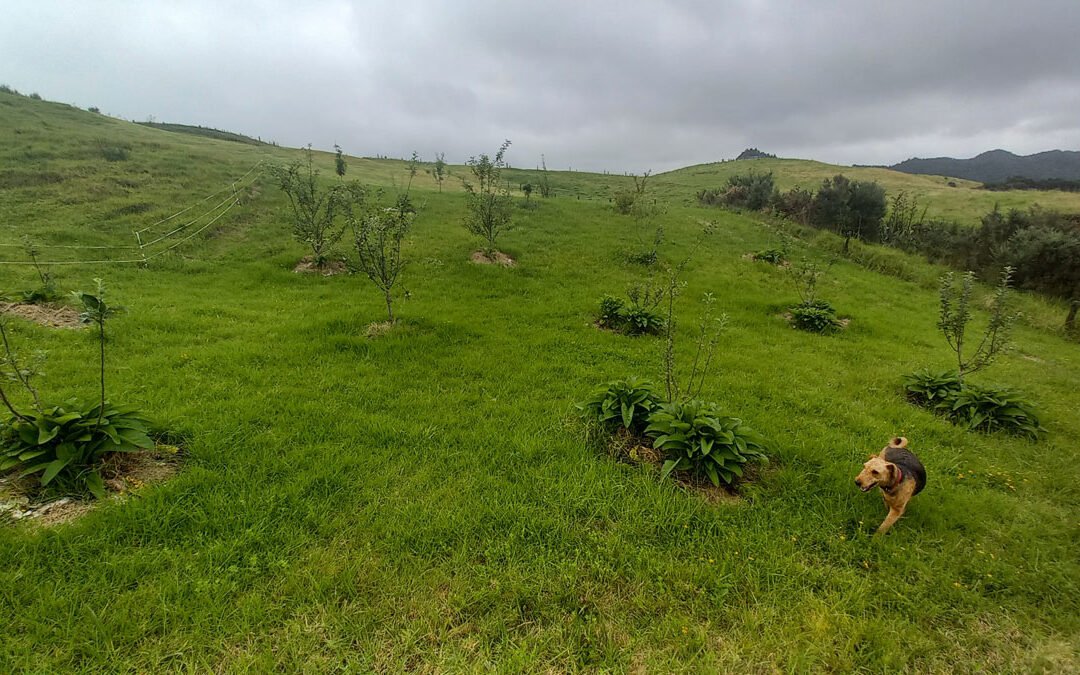One goal I set myself this year was to spread comfrey (Syphytum officinale) under all the trees in our orchard.
It was already growing below the first 12 apple trees when we moved here – you can see it mainly on the left in the image above. I was happy about that, but it turns out it is possible to kill comfrey – simply add 2 dozen layers of cardboard!
In the end, our extreme mulching a couple of years ago didn’t kill all the comfrey. But it did knock it back, and we’ve planted more trees since we moved in.
I knew at some point I’d re-introduce it – it’s very easy to propagate. I won’t need to buy any new plants. We have everything I need growing right there, I just need a spade.
But comfrey is a bit of a prickly plant. Some consider it to be invasive. There are a few concerns about its toxicity. Why am I spreading it about?
Forever fertiliser
Comfrey’s biggest advantage is its very long taproot. It’s able to reach minerals deep below the soil and draw them to the surface. It’s what’s known by organic farmers as a dynamic accumulator.
Those minerals end up in the comfrey’s leaves. They’ve been shown to contain a bunch of important macro and micronutrients. These include calcium, potassium, phosphorus, iron, magnesium, selenium, sulphur, copper, and zinc.
As the comfrey dies back in winter, those nutrients are released back into the soil. In spring, they’re ready and waiting for your fruit tree to access as it comes out of dormancy.
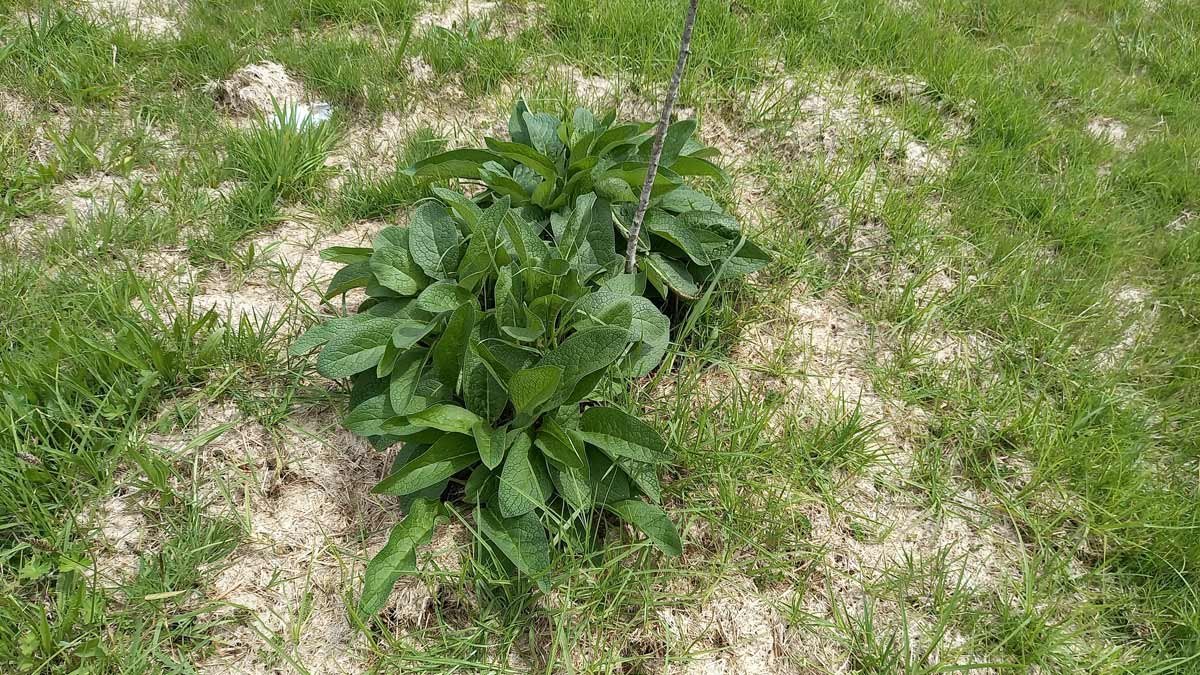
That makes comfrey a passive fertiliser and soil improver. It helps my trees to access nutrients they can’t reach themselves.
Having comfrey spaced around the trunk of each fruit tree means it’s feeding my tree. Even when I get busy with other things.
Comfrey leaves can also be added to compost, worm farms, or used to make compost tea if you want to give your other systems a boost. I’m also introducing it near my compost systems while I’m at it to take advantage of this.
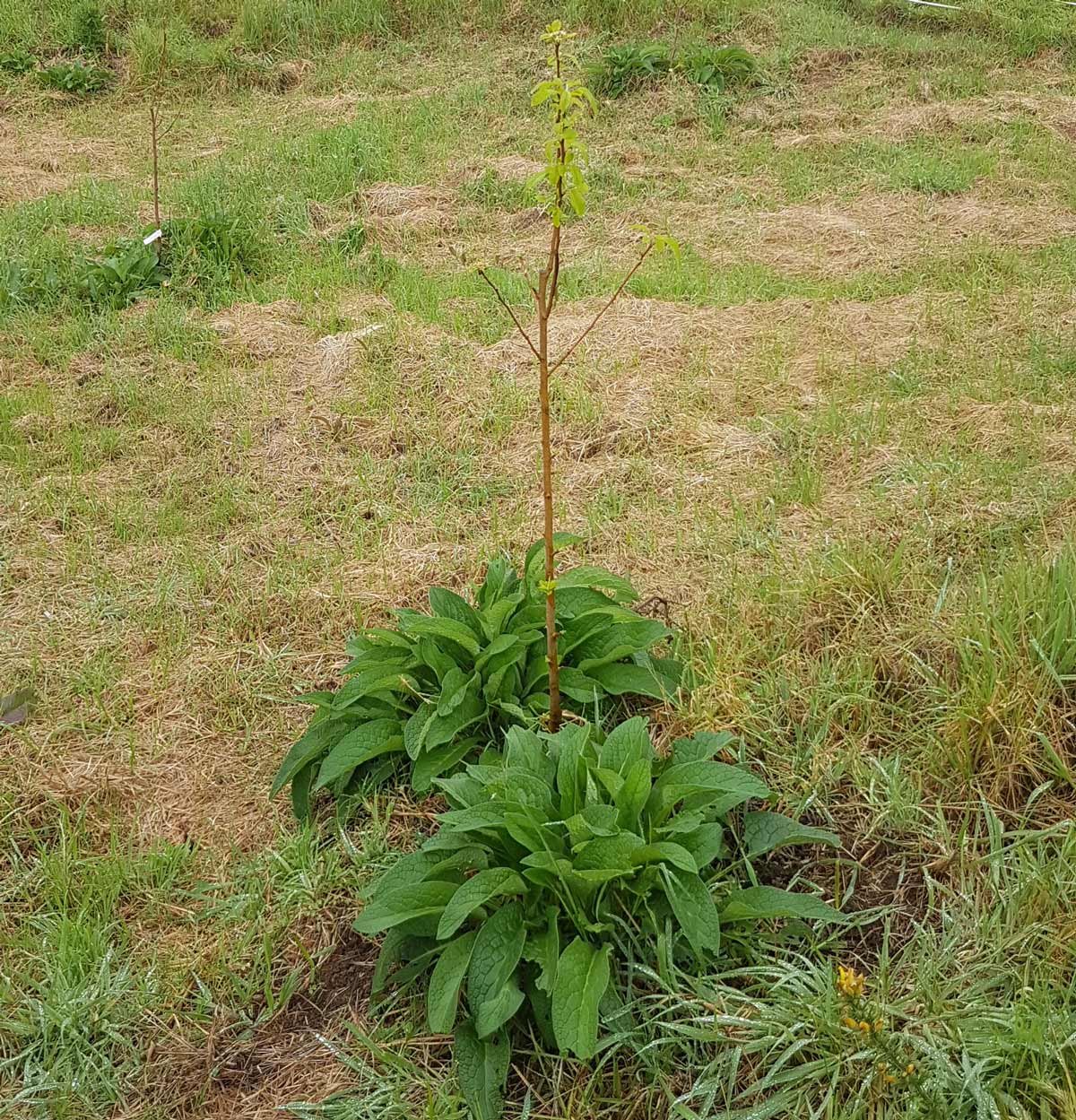
Living mulch
Comfrey’s large leaves help protect the roots of your fruit tree over dry summer months by providing shade. This helps retain moisture in the soil without the need for endless rounds of mulch. The comfrey is your mulch!
The shade will help keep grass down around your tree. Comfrey’s deep tap roots means it can compete with even very aggressive grasses, while preventing the grass from competing with the shallower roots of your fruit tree.
When you need to access your trees to harvest or prune, you might need to cut the leaves back. Get in there with the mower (with the blades up high) or flax cutter and some gloves. Cut it back 5-10cm above the crown.
The leaves can be left right there as a mulch – ‘chop and drop’ style. They’ll break down and provide nutrients back to your tree. Don’t worry, it’ll grow back.
Good for all
Comfrey has a high calcium content, so it’s another good plant to have near your chicken coop. Feeding chickens comfrey leaves will improve the strength of your egg’s shells, and make the yolks yellower.
Calcium is also important for strong cell growth in plants – so including comfrey in your composts will improve plant health in your garden too.
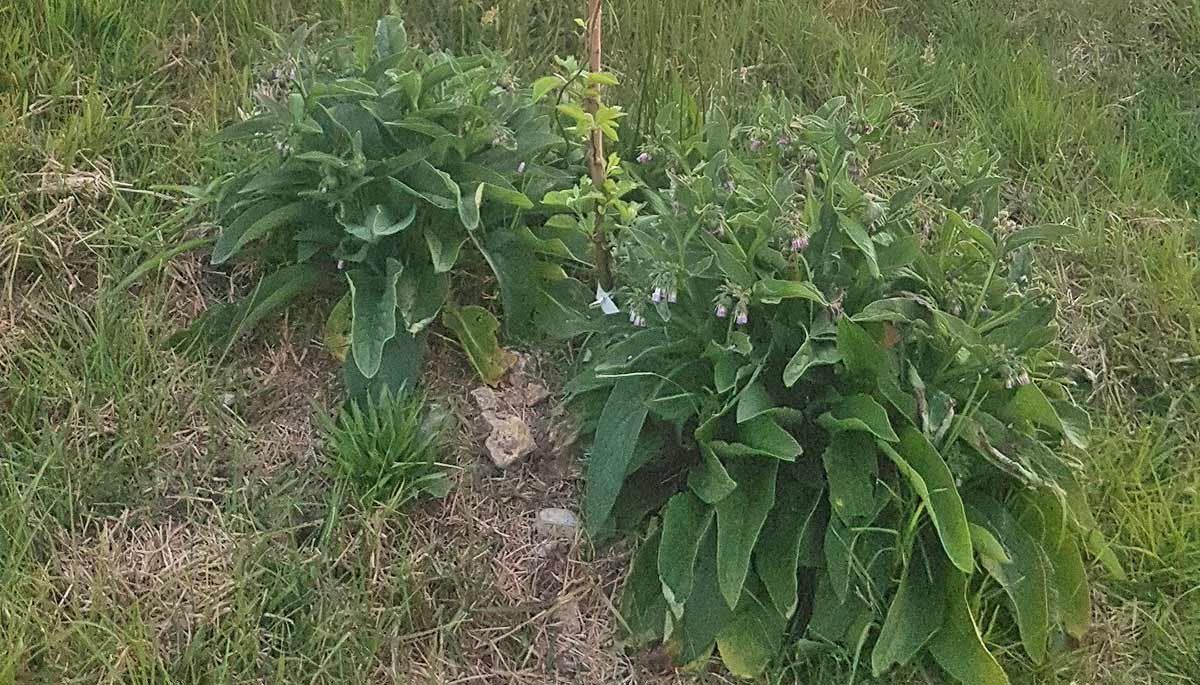
It’s related to borage, and bees (especially bumble bees) adore the flowers which appear over summer.
Comfrey has a long history in herbal medicine as a healing accelerator. This comes down to a compound called allantoin, which is used within the cosmetics and pharmaceutical industries as an anti-irritant and moisturising ingredient.
Traditionally, a poultice of crushed fresh comfrey leaves can be used to heal sprains, strains and broken bones. An alternative name for comfrey is ‘Boneset’. The large leaves can be wrapped around a limb like a cast.
I’d still go to an actual doctor for a broken bone, but it’s a good additional resource to have around for more minor strains and sprains.
Some warnings about comfrey
Some people worry that comfrey is difficult to eradicate, or that it will spread. And truthfully, every little bit of root fragment will grow, so this is not unfounded.
It is difficult to eradicate – but not impossible. A very thick mulch applied over several years will get rid of it eventually.
But it will only spread if you disturb the roots. So it’s a plant that needs to be put in the right place (like under your fruit trees). If you leave them alone and harvest the leaves, it won’t spread very far at all – it’s barely moved in our orchard over 5 years. The flowers appear to be sterile.
There are concerns in regards to eating it which apply to both humans and stock. Some of my older herb books really go on about how tasty it is, and how beneficial a herbal tea made from it can be.
But more recently concerns have been raised about the pyrrolizidine alkaloids contained mainly in the roots, but also in the leaves. These compounds are believed to cause liver issues and therefore you should probably avoid eating comfrey, or taking it internally, especially if you have problems there.
Growing comfrey
Comfrey is really easy to propagate. I got started this week by taking a spade to the tops of a couple of clumps to see what that would give me.
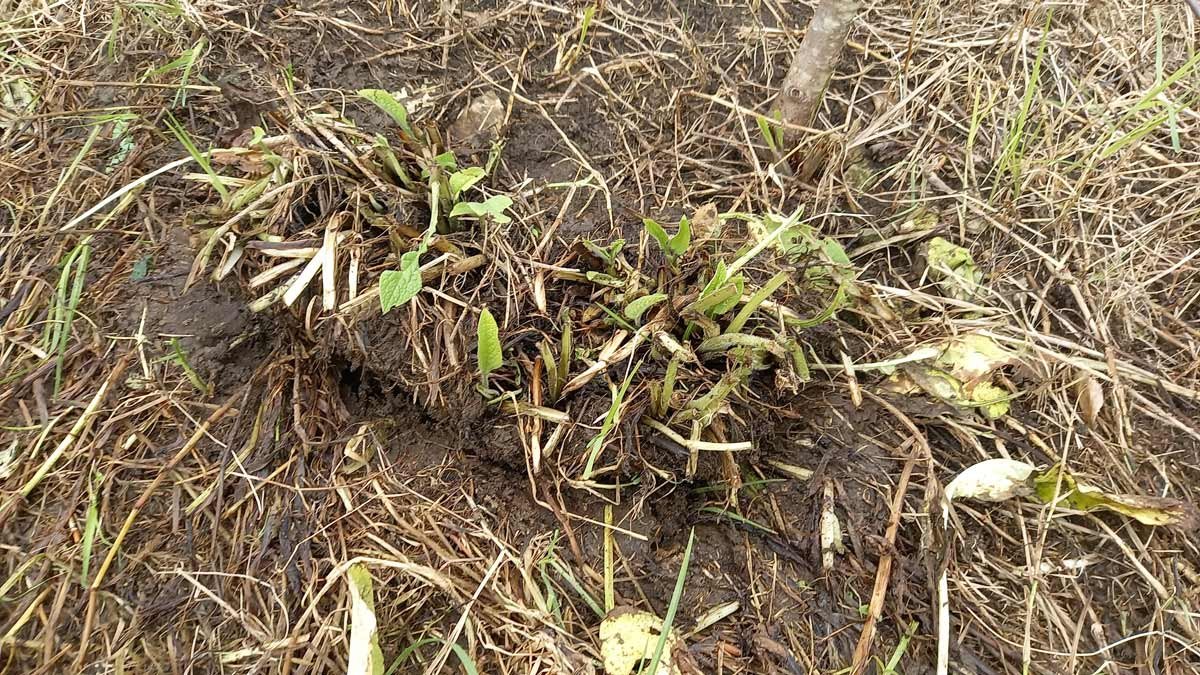
Two clumps of comfrey after cutting the leaves back and spading around to lift them.

The same clumps after lifting – the cut roots will re-grow in spring.
When I got them back up to the compound and sorted them, I had 32 crowns and dozens of root fragments. I can use all these pieces to begin at least 70 new plants.
The roots I left in the original site will grow back next season – probably twice as hard.

L to R: Root fragments, crowns, waste. I don’t want to put the ‘waste’ into my compost systems or garden in case it contains rogue root fragments! I’ll take it back to the orchard and throw it back where it came from.
Because it’s still pretty cold, I decided to get these pieces started in trays up at the compound, and plant them out in early spring when they’re bigger and it’s a bit warmer.
I filled the trays with potting mix and planted my crowns and root fragments to give them a bit of a head-start against snails and kikuyu.
I’m pretty sure this will give me more than enough comfrey to hit my goal of 4 plants around every tree, plus a few extras to start growing near
Sourcing comfrey
Look – I can sell you some comfrey, I have plenty. But it’s something that’s better sent in spring when it will start growing as soon as it hits the ground. So before I go to the effort of figuring out how much I have and making a listing, I’d like to judge the interest.
I’m thinking $12 + postage for 4 crowns – enough to surround one fruit tree. Or plant one under 4 trees and propagate the crowns for a couple of years.
If you’re interested in that, leave a comment below or get in touch some other way. I’m happy to make the effort if there’s demand. Or just supply individuals individually if that’s the way it works out.
Now you’re more familiar with comfrey and all its wonderful benefits, you might spot it locally in a community garden or at a friend’s house. Always ask first, but anyone familiar with how it grows will probably be happy for you to take some crowns in late winter and early spring while it’s dormant.
Otherwise you’ll find comfrey in the herb section of your garden centre in spring and summer (look for the ‘Living Herbs’ range); and from other specialist sellers like Kōanga Institute and Twin Falls Nursery.

